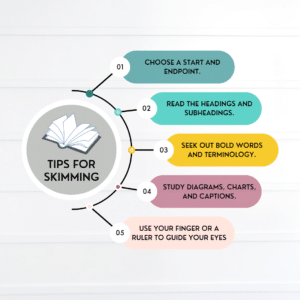04 Effective Reading Strategies that you should know
Introduction
Reading is a crucial skill for mastering English proficiency. Effective reading strategies help improve comprehension, speed, and retention. This lesson focuses on four essential reading strategies: scanning, skimming, inferencing, and predicting.
1. Scanning
Definition: Scanning is a reading technique used to find specific information quickly without reading every word. It involves moving your eyes rapidly down the page to locate keywords or phrases.
When to Use:
- Looking up a word in a dictionary
- Finding a specific date or number in a text
- Searching for a particular section in a document
How to Practice:
- Identify Keywords: Before scanning, determine the specific information you need.
- Move Your Eyes Quickly: Sweep your eyes across the text in a zigzag or vertical pattern.
- Use Visual Cues: Look for headings, bold or italicized words, and bullet points.
Example Exercise: Find the phone number for customer support in a product manual.
2. Skimming

When to Use:
- Reviewing a book before a test
- Getting the main points of an article
- Browsing through a magazine
How to Practice:
- Read the Title and Subtitles: These give you an idea of the topic.
- Focus on the First and Last Sentences: These often summarize the paragraphs.
- Look for Keywords and Phrases: These help identify important points.
Example Exercise: Skim an article to find out the main argument and key supporting points.
3. Inferencing
Definition: Inferencing involves using context clues and prior knowledge to understand meanings that are not explicitly stated in the text. It requires reading between the lines.
When to Use:
- Understanding implied meanings
- Reading literature or complex texts
- Answering comprehension questions
How to Practice:
- Use Context Clues: Pay attention to the words around the unfamiliar word or phrase.
- Relate to Prior Knowledge: Think about what you already know about the topic.
- Ask Questions: Consider who, what, where, when, why, and how to understand the underlying meaning.
Example Exercise: Read a paragraph and infer the emotions of the characters or the author’s attitude.
4. Predicting
Definition: Predicting involves anticipating what will happen next in a text based on clues provided in the material and your own experience.
When to Use:
- Engaging with a story or novel
- Making sense of a complex argument
- Preparing for what comes next in a lecture or presentation
How to Practice:
- Look for Clues: Pay attention to headings, subheadings, pictures, and graphs.
- Use Prior Knowledge: Think about similar texts you have read.
- Make Logical Guesses: Based on the information provided, predict the next part of the text.
Example Exercise: After reading the first chapter of a novel, predict what will happen next in the story.
Read More Here
English fluency course